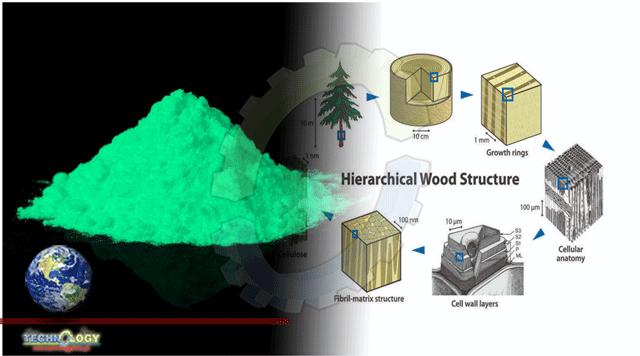Inspired by the afterglow room-temperature phosphorescence of natural basswood, researchers have prepared a series of new sustainable phosphorescent materials by confining lignin, a major component of wood, within a 3D polymer network that mimics the wood matrix.

Room-temperature phosphorescence is when a material absorbs energy with a short wavelength (such as UV light) and then emits it as visible light.
This contrasts with fluorescent materials, which immediately emit the light again and stop glowing when the light is switched off.
Professor Zhijun Chen, a researcher in the Engineering Research Center of Advanced Wooden Materials at Northeast Forestry University, and colleagues found that basswood naturally and weakly phosphoresces, releasing light for a few milliseconds due to lignin being trapped within a 3D matrix of cellulose.
This inspired them to mimic the glowing properties by crosslinking lignin within a 3D polymer network, which caused it to glow visibly for around one second.
“It is indeed an unexpected and interesting discovery,” Professor Chen said.
“We think this work will not only provide a new option for sustainable afterglow materials but is also a new route for the value-added utilization of lignin, which is the main naturally occurring aromatic polymer, and the pulping industry produces 600 trillion tons per year.”
The researchers found by tweaking the cavity sizes within the 3D polymer network, and varying drying times of the polymer, they could alter the duration of the phosphoresce.
“All lignin glows weakly, but most of the light energy is lost by vibration or movement of the lignin molecules, meaning it isn’t clearly visible to the naked eye,” said Professor Tony James, a researcher in the Centre for Sustainable Circular Technologies at the University of Bath.
“We’ve found that immobilizing the lignin in an acrylic polymer means more energy is emitted as light — in other words, the less it rattles about, the more it glows.”
“Most current phosphorescent materials are either toxic or difficult to prepare, so we wanted to develop a new material that overcame these limitations.”
“Although there is room for improvement, our new material shows great potential for making a more stable, sustainable, biodegradable non-toxic phosphorescent material that could be used in a range of applications.”
A paper on the findings was published in the journal Cell Reports: Physical Science.
Originally Publishedx By SciNews